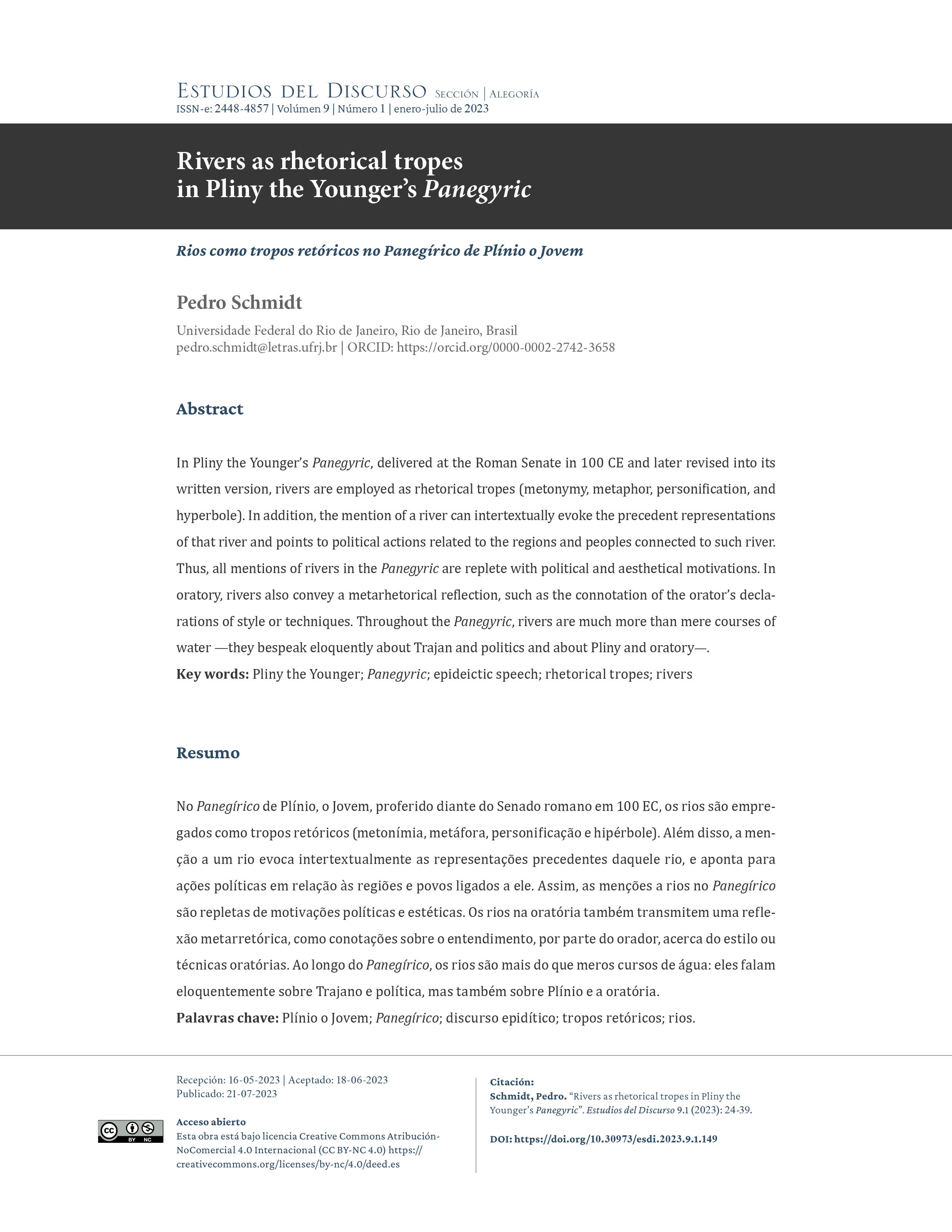Rivers as rhetorical tropes in Pliny the Younger’s Panegyric
DOI:
https://doi.org/10.30973/esdi.2023.9.1.149Palabras clave:
Plinio El Joven, Discurso epidíptico, retórica, RiosResumen
In Pliny the Younger’s Panegyric, delivered at the Roman Senate in 100 CE and later revised into its written version, rivers are employed as rhetorical tropes (metonymy, metaphor, personification, and hyperbole). In addition, the mention of a river can intertextually evoke the precedent representations of that river and points to political actions related to the regions and peoples connected to such river. Thus, all mentions of rivers in the Panegyric are replete with political and aesthetical motivations. In oratory, rivers also convey a metarhetorical reflection, such as the connotation of the orator’s declarations of style or techniques. Throughout the Panegyric, rivers are much more than mere courses of water – they bespeak eloquently about Trajan and politics and about Pliny and oratory.
Descargas
Citas
Barreda, F. El Panegirico de Plinio en Castellano. Madrid: D. Antonio Espinosa, 1787.
Bondioli, N. “Panegírico de Trajano: da Antiguidade ao presente”. Faces da História 4.2 (2017): 139-50.
Campbell, B. Rivers and the Power of Ancient Rome. Chapel Hill: University of North Carolina Press, 2012.
Fantham, E. “Two Levels of Orality in the Genesis of Pliny’s Panegyricus”. In: Mackay, A. Signs of Orality: The Oral Tradition and its Influence in the Greek and Roman World. Leiden: Brill, 1998.
Fedeli, P. “Il ‘Panegyrico’ de Plinio nella critica moderna”. Aufstieg und Niedergang der römischen Welt 33 (1989): 387-514.
Henderson, J. “Down the Pan: historical exemplarity in the Panegyricus”. In: Roche, P. Pliny’s Praise: The Panegyricus in the Roman World. Cambridge: Cambridge University Press, 2011.
Hutchinson, G. “Politics and the sublime in the Panegyricus”. In: Roche, P. Pliny’s Praise: The Panegyricus in the Roman World. Cambridge: Cambridge University Press, 2011.
Jones, P. Reading Rivers in Latin Literature and Culture. Oxford: Lexington Books, 2005.
Manolaraki, E. “Political and Rhetorical Seascapes in Pliny’s Panegyricus”. Classical Philology 103.4 (2008): 374-94.
Morford, M. “Iubes esse liberos: Pliny’s Panegyricus and Liberty”. American Journal of Philology 113.4 (1992): 575-93.
Noreña, C. “Self-fashioning in the Panegyricus”. In: Roche, P. Pliny’s Praise: The Panegyricus in the Roman World. Cambridge: Cambridge University Press, 2011.
Radice, B. “Pliny and the Panegyricus”. Greece & Rome 15.2 (1968): 166-72.
Rees, R. “To be or not to be: Pliny’s Paradoxical Trajan”. Bulletin of the Institute of Classical Studies 45 (2001): 149-68.
Rowe, G. “The Adynaton as a Stylistic Device”. The American Journal of Philology 86.4 (1965): 387-96.
Schmidt, P. “Exagerando a verdade: a hipérbole em Quintiliano”. In: Albertim, A. & Soares, W. Escritos clássicos greco-latinos. João Pessoa: CCTA, 2020.
West, M. Indo-European Poetry and Myth. Oxford: Oxford University Press, 2007.

Descargas
Publicado
Cómo citar
Número
Sección
Licencia
Derechos de autor 2023 Estudios del Discurso

Esta obra está bajo una licencia internacional Creative Commons Atribución-NoComercial 4.0.
La revista Estudios del Discurso está bajo una Licencia Creative Commons Atribución-NoComercial 4.0 Internacional, de tipo CC BY-NC, de modo que es posible compartir y adaptar el material, pero debe darse crédito a la obra de manera adecuada e indicar si se han realizado cambios; no puede hacerse uso del material con fines comerciales. Estudios del Discurso proporciona un acceso abierto inmediato a su contenido e investigaciones; se autoriza copiar, distribuir y comunicar públicamente cualquiera de los textos publicados, siempre que se cite de manera adecuada la fuente y se remita a la publicación original. Los autores tienen libertad de diseminar su trabajo y hacerlo disponible en otros lugares, siempre y cuando den crédito a la publicación original y, de ser posible, proporcione una liga directa a la misma. Esta revista no solicita cobro de tarifas hacia los autores para la evaluación o procesamiento de los artículos.

